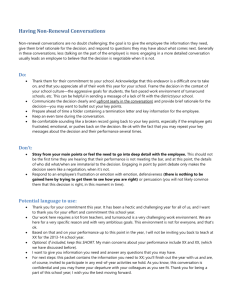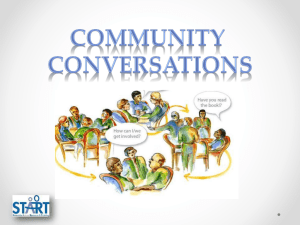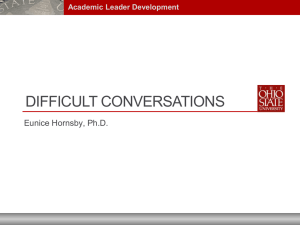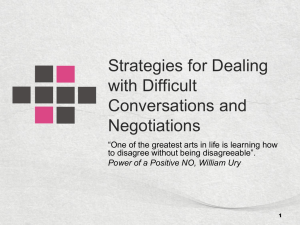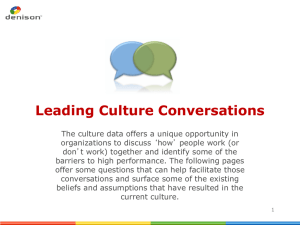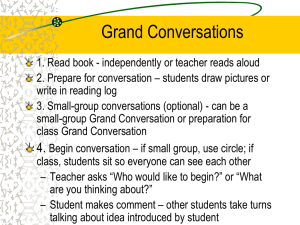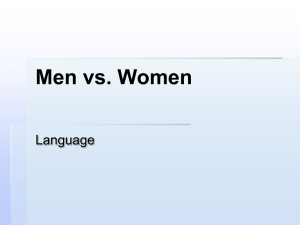Managing Difficult Conversations
advertisement
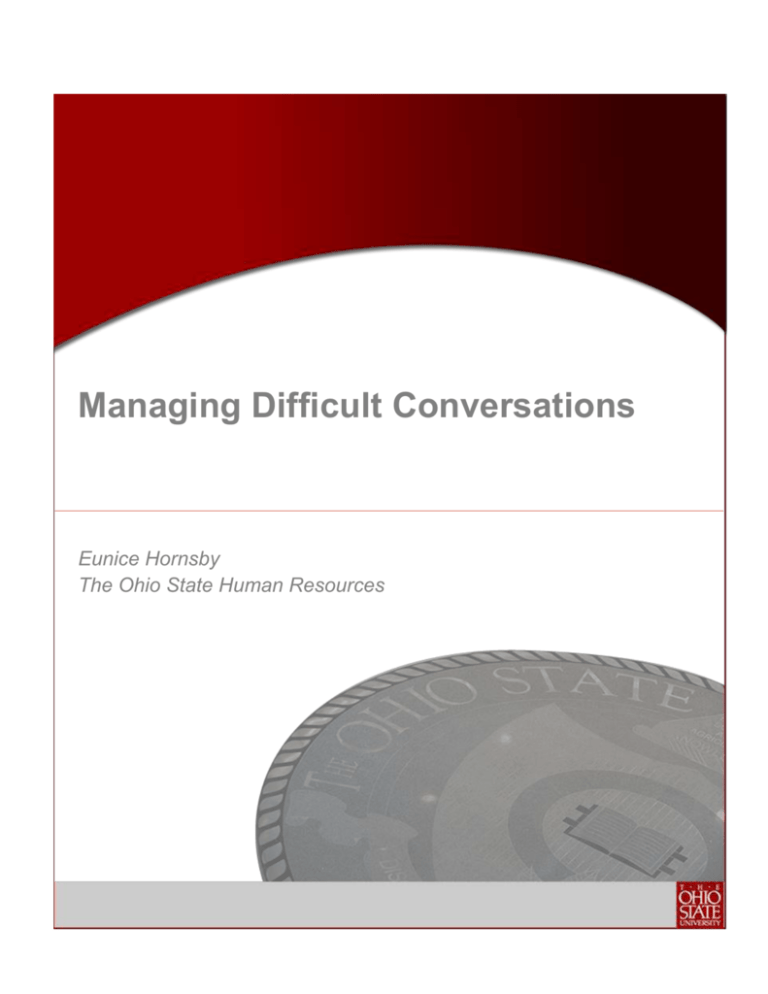
Managing Difficult Conversations Eunice Hornsby The Ohio State Human Resources Managing Difficult Conversations Introduction Every relationship is a series of conversations. If you are interested in learning how healthy your relationships are with your life partner, immediate colleagues, those in a position to evaluate you, or anyone else, ask yourself, “What are the last five conversations I have had with him/her/them?” If you are interested in changing a relationship, change the conversation. Those who are extraordinary in what they do are completely responsible for what they say and how others interpret what they say. “I’ve learned that people will forget what you said, people will forget what you did, but people will never forget how you made them feel.” Maya Angelou Leadership is exhibited through conversations. Some conversations are more challenging than others. Conversations can be “difficult” because of you, your current situation, your history and experiences, the other person, their current situation and/or their history and experiences. If you are expecting that a conversation will be difficult, it’s important to get grounded in what’s going on inside of you. Knowing yourself, why you’re feeling a certain way, and why this is important to you, will help you engage productively with the other person. Once you’re clear on “you,” then you can focus your attention on him/her. Before beginning a difficult conversation, spend time reflecting on: 1 What is the issue? Why is it bothering you? What gets you hooked about this conversation, person or issue? What are your assumptions about what’s going on? What emotions are attached to the situation? What is your purpose in having the conversation? What is the ideal outcome? What will happen if you have the conversation? What will happen if you don’t? Managing Difficult Conversations Tools for Difficult Conversations Tool #1: Make it Safe to Talk A safe conversation is one in which both parties feel comfortable expressing their thoughts and feelings without negative ramifications and without feeling threatened. To make a conversation safe: Embrace a mutual purpose. Care about the interests of others as well as your own. Offer mutual respect. The instant someone perceives disrespect in a conversation, the interaction is no longer about the original purpose – it is now about defending dignity. When another misinterprets your purpose or intent, use a contrasting statement. A contrasting statement is a don’t/do statement that clearly states the message you are NOT trying to send and then states the message you ARE trying to send. Example: “I am not trying to say that my program is more important than yours. I am trying to communicate that we both have high stakes involved in terms of the success of our programs.” Tool #2: Listen “Seek first to understand and then to be understood” is a phrase that should never be lost. Each of us experiences the world differently. Another way to describe this is that each of us sees the world through a unique set of filters. Our filters cause each one of us to see things differently from anyone else --- they “color” our experience of everyday life. We all have filters. The following is a list of typical filters that operate for many people: Past experiences Gender Training Values Age Discipline Beliefs/thought habits Race State of mind or moods Religion These filters, combined with our moment-to-moment thinking, create what is known as selective perception. What we focus on in any given situation is shaped by our filters and our thinking. We have a tendency to believe that we can see the “whole picture.” We think that what we see is what others see, or should see. This tendency is at the core of many conflicts. At times we become inflexible because we believe that our perception is the “truth” and others are wrong. The reality is that there is no right or wrong. Each of us sees things differently. 2 Managing Difficult Conversations “We see the world as we are, not as it is.” Anais Nin Because we have differing perceptions, and we make assumptions about another’s intent, we have to get ourselves in a place where we can listen and really hear how the other person views a situation, what his/her true intentions are. Good listening in a difficult situation requires an open and honest curiosity about the other person, and a willingness and ability to keep the spotlight on him or her. Use the following skills to be the very best listener: Forget the words, focus on authenticity. Authenticity means that you are listening because you are curious and because you care, not just because you are supposed to. Listen to your own internal voice. Negotiate your way to curiosity (quieting your internal voice), to truly understanding the other person, or express what’s going on for you. “I have to admit that as much as I want to hear what you have to say, I’m feeling a little defensive right now.” Ask open-ended questions. “Tell me more…” “Help me understand…” Paraphrase for clarity. Express to the other person, in your own words, your understanding of what he or she is saying. Acknowledge the other person’s feelings. Unless acknowledgement is offered, feelings are likely to cause trouble in a conversation. 3 Managing Difficult Conversations Tool #3: Adopt the “Yes, and…” Stance The "yes, and…” concept validates differing perceptions of the same situation; both your view of the situation, and that of another person, have value and you do not have to choose which one is right. You can embrace both and then work at understanding the other person's point of view. After listening to another person’s story or perception, don’t feel like you have to give up your own. The “yes, and…” stance allows you to recognize that the way you each see things matters, and the way you each feel matters. The “yes, and…” stance is based on the assumption that the world is a complex place. You can feel hurt, angry and wronged and they can feel equally hurt, angry and wronged. You can be certain you said what you said and they can be just as certain they heard what they heard you say. Example: “I now understand that you walked away feeling isolated and lonely. I also walked away from the meeting feeling unheard and dismissed.” The critical component is that you allow yourself to express your view and listen to the other person's view as well. Once you have reached this stage, you can say: "Now that we really understand each other, what's a good way to resolve this problem?" Tool #4: Recognize Your Stories We tell ourselves stories when we add meaning to another’s behavior without checking if our conclusions are right. Often these stories play silently and repetitively in our heads. Our thinking is so automatic, we are oftentimes not even aware that a conclusion we’ve made is only an assumption. The very nature of assumptions is that at the time they are made, they do not feel like assumptions at all; they simply feel like the truth. To prevent yourself from leaping to assumptions about another’s intent, ask yourself three questions: 1. Actions: “What did the other person actually say or do?” 2. Impact: “What is the impact of this on me?” 3. Assumptions: “Based on this impact, what assumption am I making about what the other person intended?” Once you have clearly answered these three questions, the next step is to make sure you recognize that your assumption about their intentions is just a guess. Your guess may be right and it may be wrong. It has definitely generated feelings for you, but your feelings may be based on incorrect conclusions. 4 Managing Difficult Conversations In conversation, you can share what you observed the other do or say (actions), how that felt (the impact), and your assumption about intentions. It is important to label the assumption as just that – an assumption or guess that is open to revision. Example: “I felt lousy when you didn’t call me. I was sure you knew that it was a big deal for me and I would want to talk about it. Because you didn’t call, I assumed you didn’t care. Tool #5: Use “I” Messages Statements that start with “you” sound accusatory and blaming. They typically evoke a defensive response in the person who hears it. Sentences that start with “I” are less inflammatory and they keep responsibility for what is expressed with the person doing the speaking. Using “I” messages (“I believe…” “I saw…” “I am concerned about…”) also emphasizes that one subjective point of view is being shared – yours! By claiming your own point of view, you are opening the door for a second point of view. Example: “I believe we should make this decision after we consider all the facts and after we have a group discussion.” Versus: “You are being an autocrat. You aren’t considering anyone’s perspective except your own.” Tool #6: Own Your Own Stuff Personal accountability is about accepting responsibility for one’s own actions and behaviors, and how those actions and behaviors may have contributed to a conflict. Blame is about making judgment about another’s behaviors. Example: “I realize I should have come to talk to you before now. I’ve been concerned about this for the last two months yet I didn’t share my concern with you.” Versus: “If you had broached this subject with me, I would have told you about my concerns. You didn’t bring it up, so I didn’t bring it up.” 5 Managing Difficult Conversations A Model/Framework for Difficult Conversations (Adapted from Scott, S., 2004, Fierce Conversations) 6 Name the issue: “I want to talk with you about…” Select a specific example: “I heard…” Describe your emotions: “I am concerned by this.” Clarify why this matters: “From my perspective this is important because…” Own your own stuff: “As I’ve thought about this, I realize that I may have contributed to the issue by…” Invite your partner to respond: “Help me understand your point of view. Tell me…” Use your best listening skills to hear what is said. Inquire into your partner’s views: “Tell me more about that.” Come from a place of curiosity, not judgment. Move into resolution using paraphrasing and the “yes, and…” stance. Identify next steps. Make an agreement. Check back in two weeks. Managing Difficult Conversations Resources and Readings Patterson, K., Grenny, J., McMillan, R., and Switzler, A. (2002). Crucial conversations: tools for talking when stakes are high. New York: McGraw-Hill. Scott, S. (2004). Fierce conversations – achieving success at work and in life, one conversation at a time. New York: Berkley Publishing. Scott, S. (2011). Fierce leadership – a bold alternative to the worst “best” practices of business today. New York: Berkley Publishing. Stone, D., Patton, B., Heen, S. (1999). Difficult conversations: how to discuss what matters most. New York: Penguin. 7
